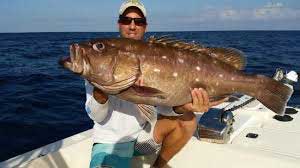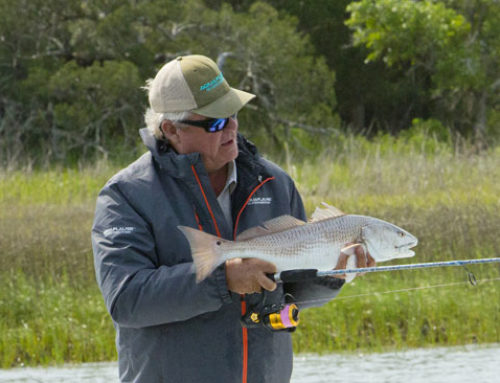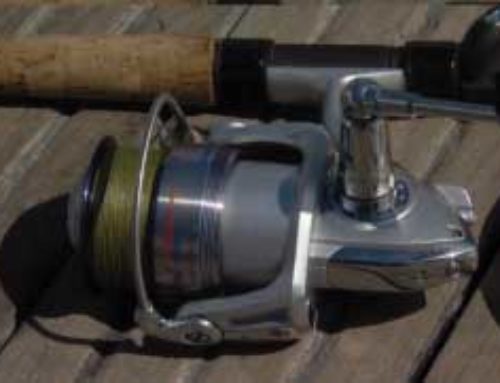As we worked our prize to the surface color developed and we soon had a glimpse at a trophy snowy grouper. Mission accomplished! While the Florida Keys are famous for the crystal clear waters leading to the cobalt blue ocean and brilliantly colored coral reefs, extensive deepwater communities exist well off the beaten path. Here, numerous species live hundreds of feet below the surface in depths of neritic and bathyal zones.
In these extreme environments small amounts of light reach the seafloor as the depths drop from the edge of the continental shelf. The neritic zone consists of the first 200 hundred meters and the bathayl zone covers depths from approximately 200 to 2000 meters below the surface. Although deep water communities along the Eastern Seaboard and Gulf of Mexico provide incredible angling opportunities, the continental shelf is closest to South Florida and The Florida Keys, making a variety of deepwater species readily available to anglers in the know. While most die-hards prefer to focus on game fish that forage the top third of the water column, look deeper and you might find a pleasant surprise.
Blackbelly rosefish, gray and golden tilefish, snowy grouper, oilfish and pomfrette are only a few of the unique and extreme predators that survive and thrive in total darkness. What makes this fishery so exciting is the fact that you really have no idea what you might pull up from the chilly, dark depths. The crowd favorite snowy grouper is found along stretches of deep water and is slow growing and long lived—key factors that make them susceptible to overfishing. Furthermore, snowy grouper are protogynous hermaphrodites, meaning they undergo a sex change from female to male as they mature, which leaves them at even greater risk.
In recent years it was determined that speckled hind and warsaw grouper were overfished and in an effort to protect these species NMFS enforced a ban on bottom fishing beyond 240-feet of water. The ban upset local captains because they knew firsthand that warsaw grouper prefer much different habitat than deep dwelling species like tilefish and snowy grouper. The ban has since been lifted and deepwater fishing is once again a viable option.
In spite of traditionalists claiming electric reels have no place in sport fishing, having a power-assist reel is the way to go when plying the deep, dark depths of the continental shelf for hard fighting snowy grouper. Dropping in the midst of harsh currents requires heavy sinkers and if you choose to fish manual tackle it will be difficult to fish the necessary amount of lead to stay in the strike zone. I know this firsthand because our first adventure with Captain Beau Woods of OO Charters in Cudjoe Key was full of misfortune.
The day started with an outboard issue that left us at the dock, yet Captain Beau reached out to a local captain and we were soon headed offshore with a borrowed boat and tackle. There were a couple of key issues to overcome including the lack of an electric socket and proven numbers from Beau’s seasoned plotter. Nevertheless, we made a few manual drops and cranked the heavy sinker from 800 feet a few times before calling it quits. A month later we were back in Cudjoe looking to conquer a mighty snowy grouper, but this time we were ready for battle. Mounted on a medium action bent-butt rod, the sophisticated Daiwa Tanacom Bull was loaded with 65 lb. Diamond Braid and ready to winch the most determined adversary from the pressurized depths below.
While Captain Beau would have it out for me if I released any of his secret numbers, you can easily find your own deep drop spots by carefully studying a nautical chart. As light penetration diminishes, the ocean becomes devoid of life and even the slightest ridge, pinnacle and cliff of the deeper depths of the continental shelf can hold life. However, simply looking at a chart won’t put fish in the box, because some of these structures are so miniscule that they can only be uncovered by sonar. And because of the extreme depths many prime areas may still be uncharted.
What you want to look for are irregular bottom contours in 500- to 800-foot depths. One of the best ways to find new drop spots is to attentively watch your sounder as you troll for assorted pelagics. With the advanced backtrack features new chartplotters and depth finders offer you can pinpoint the structure and zero in on prized deep dwellers. Set your sonar to 200 kHz and keep your depth finder zoomed in with bottom lock.
“Some of my best deep drop numbers were found by accident when trolling for dolphin,” noted Captain Beau. “Once you’ve found a promising structure you’ll want to set up a drift to see how you need to set your approach in relation to the current, wind and arrangement of structure below. While jagged ledges and rocky bottoms hold fish, you don’t want to overlook muddy bottoms either,” continued Woods.
When fishing this deep you’ll need specialized terminal tackle beyond an electric reel. At depths deeper than 400 feet light penetration is minimal and the introduction of an artificial light source to the dark environment is a highly recommended approach. Circle-hooks are also a must, with a 6X strong high carbon steel 11/0 VMC #9788 providing solid hooksets. Many anglers make their own deep drop rigs consisting of 8 feet of 300 lb. monofilament and since new regulations only allow for the harvest of one snowy grouper per vessel per day, compared to three per person in years past, anglers have adapted their rigging and presentation in hopes of eliminating strikes from juveniles. When pulling snowy grouper to the surface the extreme pressure change makes them impossible to release, so you have to make your first fish count. Typical rigs that once consisted of multiple hooks have now been streamlined to present one or two baits in hopes of connecting with the right fish. For the best results fish large baits like whole squid, barracuda or bonito slabs and go for glory.
Snowy grouper are eager to strike and if you’ve found an area of productive bottom it shouldn’t be too difficult to get connected. Deep dropping isn’t something you’ll do all day every day, but it’s a fun and exciting change of pace that provides dependable cold water fillets. Break the mold of typical angling pursuits and explore all Florida has to offer.





